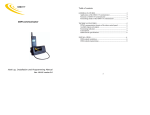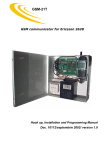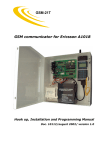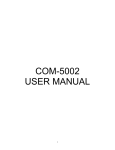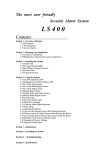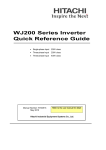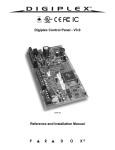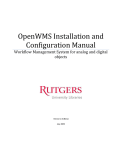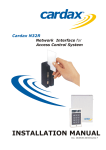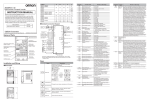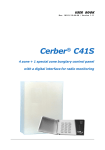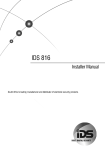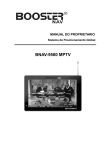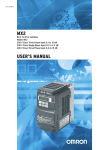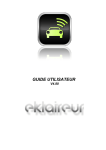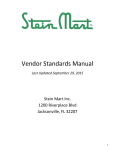Download Cerber C62 - ElektroMech
Transcript
Cerber C62 6-Zone and 2-Partition Burglary Control Panel For your home and office User’s manual Doc 10401/ 08.08.2005/ version 1.9 1. INTRODUCTION .....................................................................................................................................................................3 General Features ..................................................................................................................................................................3 User Codes ..........................................................................................................................................................................3 Installer Codes .....................................................................................................................................................................3 Digital Communicator ............................................................................................................................................................4 Upload/Download..................................................................................................................................................................4 Zones..................................................................................................................................................................................5 PGM functions ......................................................................................................................................................................5 Monitoring of system troubles .................................................................................................................................................5 Voice messages (synthesis sounds) Communicator.....................................................................................................................5 Miscellaneous .......................................................................................................................................................................6 Technical Specifications: ........................................................................................................................................................6 2. KEYPADS ...............................................................................................................................................................................7 Keypad types .......................................................................................................................................................................7 Keypad layout ......................................................................................................................................................................7 Functional Keys ....................................................................................................................................................................9 3. OPERATION ...........................................................................................................................................................................9 System codes ..................................................................................................................................................................... 10 User Codes ........................................................................................................................................................................ 10 Installer’s Codes ................................................................................................................................................................. 10 Partitioning ........................................................................................................................................................................ 11 Regular / Away Arming ........................................................................................................................................................ 11 Other Arming Modes............................................................................................................................................................ 12 Timed Autoarming............................................................................................................................................................... 12 Inactivity Autoarming .......................................................................................................................................................... 12 “Instant Stay” Arming.......................................................................................................................................................... 12 “Stay Arming” .................................................................................................................................................................... 14 Switch To Stay Arming......................................................................................................................................................... 15 Keyswitch or Pushbutton Arming/Disarming ............................................................................................................................ 15 Quick Arming Modes (Arming without user codes) .................................................................................................................... 15 “Away Quick Arming”........................................................................................................................................................... 15 “Quick Instant Stay Arming” ................................................................................................................................................. 15 “Quick Stay Arming”............................................................................................................................................................ 16 Disarming & Deactivating an Alarm........................................................................................................................................ 16 Zone bypassing .................................................................................................................................................................. 17 System Trouble Status Displaying: [*][4] comand ................................................................................................................... 17 Alarm Memory Displaying: [*][5] .......................................................................................................................................... 18 A different display method for the alarm memory (available only for KP-064EP keypads) ............................................................... 19 Chime Feature activating/deactivating.................................................................................................................................... 20 Activation (Deactivation) of PGM Outputs / Starting (Finishing) the Rounds.................................................................................. 20 4. Master User’s Programming Menus .....................................................................................................................................21 Programming / Selective Erasure (except the “master code”) of 01 to 45 User Codes .................................................................... 22 Simultaneous Erasure of all users' codes (except the “master code”) .......................................................................................... 25 Programming / Selective Erasure of the 1 to 4 follow me Phone Numbers .................................................................................... 25 Selective Erasure of the follow me phone numbers ................................................................................................................... 26 Simultaneous Erasure of all Follow me Phone Numbers ............................................................................................................. 27 Programming session of the system time and date ................................................................................................................... 27 “Ambush Digit Programming” (“master user’s submenu” [61]) ................................................................................................... 28 Other Operation Commands Performed by the master user ....................................................................................................... 28 PC download acceptance ...................................................................................................................................................... 29 Voice / Sound Reporting and Communication with PC Cancellation.............................................................................................. 30 Keypad Special alarms ......................................................................................................................................................... 30 Warning Limitations of Alarm Systems ................................................................................................................................... 31 2 1. INTRODUCTION GENERAL FEATURES • Central unit's core of powerful RISC microprocessor; • The electrical features include an EEPROM memory for the programmed configuration, system/partitions status and LOG buffer to be retained even after a total power loss; • User-friendly programming of the system parameters, from keypad or by PC (using “EZcom C62 Software”); • Up to 400 events with time and date stamp can be stored in a FIFO LOG buffer; • “False alarm prevention” features: intellizones, automatic zone shutdown, beeps on entry and exit delays; • Features of “sensor under test” for easy detection of the sensors which produce false alarm. • High-speed pre-programmed or programmable Communication Formats; • 45 user codes (1-st being “master code”) and 2 installer’s codes (programming and maintenance codes); • Keypad displayed alarm memory for the first 9 alarms occurred in the system since last arming; • Up to 4 keypads which can be simultaneously 4-wire coupled to one central unit; • Keypad protection using micro-switch tamper; • Individual zone LEDs from 1 to 6, indicating the alarm and faulted status; • Each zone accepts tamper recognition by zone attribute programming and 2EOL wiring • System status LEDs: READY, SYSTEM, ARMED A and ARMED B; USER CODES 45 programmable “user codes” (1-st being “master code”) with 11 programmable rights: • Zone bypassing; • Regularly arming; • Stay arming; • Force arming; • Disarming/siren stopping; • PGM1 activating/deactivating; • PGM2 activating/deactivating; • Access to partition A; • Access to partition B; • Starting the rounds; • Finishing the rounds; • All users have “ambush capability” (by pressing the key which corresponds to the “ambush digit”, before the 4 or 6 digits of any user code, then the control panel will transmit a special code to the central station). INSTALLER CODES • 2 programmable installer’s codes: installer’s programming code and installer’s maintenance code (the first installer’s code is only for system parameter programming and the second one with same 11 programmable rights and “ambush capability” as the 45 user codes, except the Disarming right which is allowed only if the system/partition was previously armed by the same code); 3 DIGITAL COMMUNICATOR • Phone line tone detection upon the automatic initiating the reporting to the central station; • 2 separate accounts and individual communicator formats to identify each partition upon transmission to “central station”; • 2 individual programmable phone numbers for transmission to CS1 and to CS2; • Alternate or Split (double) reporting to CS1 and to CS2; • 1 FIFO buffer which storages up to 80 events for transmission to CS, without erasing the old events in case of “CS1 and CS2 communication failed” event, if alternate reporting is selected; • 2 FIFO buffers which storage up to 80 events each, for transmission to CS1 and to CS2, without erasing the old events in case of “CS1 communication failed” event and/or “CS2 communication failed” event, if split (or double) reporting is selected; • Adaptive algorithm to function with central stations which frequencies in any order and kiss-off time from 0.6 to 3 seconds; generate handshake • Many communicator formats - DTMF Ademco Contact ID and several 4x2 formats (10PPS, 20PPS, 40PPS and DTMF Ademco Express); • Programmable data and handshake frequency and transmission speed in 4x2 format: Ademco Express, 10PPS, 20PPS or 40PPS with parity/no parity, data of 1800 (or 1900) Hz and handshake of 1400 (or 2300) Hz; • Periodical test reporting (with steps of up to 255 minutes or hours, time adjustment of the starting and either unconditionally reporting or only while armed status); • Programmable reporting codes for “zone alarming”, “zone restore” and “zone bypassing” (automatic “from swinger” or by the panel - during home arming periods, if the zones have the attribute “stay” - and manually by the users); • Programmable zone restore (the “zone restore event” is recorded either in real time for each violated zone, when the violated zone “closed back”, or upon bell cut-off, for all zones that previously triggered the alarm); • Programmable reporting codes for Arming/Disarming/Ambush events, according to the user code; • Programmable reporting codes for system trouble situations: “Low battery voltage”, “Restore battery voltage”, “AC power loss”, “AC power Restore”, “Bell Trouble” (upon disconnection or overload on the siren), “Bell trouble Restore” (Restore of disconnection or overload on the siren), “AUX overload”, “AUX overload Restore”, “ System time and date Loss”, “System time and date Reprogrammed”, “Keypad lockout”; • Cancellation of reporting to CS may be performed only by installer. UPLOAD/DOWNLOAD • Several upload/download operations: - Uploading the system parameters from control panel onto PC (actually, onto “EZcom C62 Software”); - Downloading the programming of system parameters from PC (actually, from “EZcom C62 Software”) onto the control panel (PC programming using “EZcom C62 Software”); - Uploading the event LOG from the control panel into the “EZcom C62 Software” (actually, in a file); - System time and date setting by PC (actually, by “EZcom C62 Software”); - System (or partitions) arming/Disarming from PC (actually, by “EZcom C62 Software”); - Zone bypassing by PC (actually, by “EZcom C62 Software”); - PGM activation/deactivation by PC (only for PGM outputs defined as “mono-stable”, “bistable” or “clock timer” types); - Online visualization of the system/partitions status and troubles onto “EZcom C62 Software”; 4 - Online visualization of the bypassed, alarmed or open zones onto “EZcom C62 Software”. • Programmable callback function with up to 3 attempts, automatic or manually activation (manually activation may be performed by master or by installer); • 400-event LOG with upload and visualizing possibility through the “EZcom C62 Software” and optionally reported to CS; • Option of automatic answers to PC calls, either after “double call” or after programmable number of rings; • Manually activation of communication with PC (PC download acceptance), performed by master or by installer; • Communication between PC and panel Cancellation, performed by master or by installer. ZONES • 6 End-of-line resistor zones, entirely programmable as delayed, instant, follower, 24 hour burglary, fire, tamper, panic, medical emergency, arming/Disarming (“keyswitch”) or round type; • 12 zone attributes, individually programmable as “audible/silent alarm”, “steady/pulsing siren”, “manually bypassing”, “auto shutdown”, “forced arming”, “chime function activating”, “stay”, “intellizone”, “sensor under test”, as well as individually selectable zone response time; • “Zone bypassing” (automatic “from swinger” or by the panel - during home arming periods, if the zones have the attribute “stay” - and manually by the users); • 2 real partitions which can be armed/disarmed independently from each other – allowed by user rights; • Individually programmable exit and entry delay times for each partition – allowed by programming; • Programmable alarm type: silent or audible and for the audible alarms steady or pulsing; • Individual siren timers for burglary and fire alarms; PGM FUNCTIONS • 2 programmable outputs, each with 31 options: “Panic alarm latch”, “Fire alarm latch”, “Medical emergency alarm latch”, “Latch on tamper alarm”, “Any alarm latch”, “Pulsing siren”, “Steady siren”, “silent alarm” latch, “Follow system status” (ON while system is armed / OFF while system is disarmed), “Entry delay”, “Exit delay”, “System troubles”, “Clock timer”, “Warning/confirmation pulses”, “Buzzer warnings during the warning round time”, “Pulse after exit delay”, “Pulse on arming”, “Pulse on Disarming”, “Courtesy light”, “Pulse on round OK”, “Pulse on round failed”, “Pulse on siren troubles”, “Retriggerable mono-stable”, “Resetable mono-stable”, “Bi-stable” and “Pulse on alarm triggered by each 1 to 6 zones”; MONITORING OF SYSTEM TROUBLES • Battery Voltage and AC power monitoring; • Siren monitoring (upon disconnection or overload); • “AUX overload” monitoring; • Option of telephone line monitoring (TLM). • Status of zone tampers (if enabled zone tamper recognition). VOICE MESSAGES (SYNTHESIS SOUNDS) COMMUNICATOR • Capability of response to the remote calls for system status interrogation (the system status -armed/disarmed/alarm/”AC power loss” – will be reported by specific voice messages or by specific synthesis sounds); • Programmable options of responses to the remote calls for system status interrogation, either after “double call” or after programmable number of rings; 5 • Programmable option of automatic initiating the reporting the specific voice messages (or the specific synthesis sounds) to the follow me phone numbers, when several “alarm” and “AC power loss” events occur in the system; • Phone line tone detection upon the automatic initiating the voice messages reporting; • Using the MPV8 voice module, up to 8 voice messages (2, 4 or 8), specific to different alarm types, to the “AC power loss” event and to the armed or disarmed system status, can be reported upon remote interrogation calls or to the follow me phone numbers; • In case of no MPV8, the panel will report upon remote interrogation calls or to the follow me phone numbers synthesis sounds; • Up to 4 follow me phone numbers (for the control panel to automatic report on the phone line the “alarm” and “AC power loss” events, by specific voice messages or by specific synthesis sounds); MISCELLANEOUS • Zone tamper activates BELL output when system is disarmed (programming option in section 20) In case of system armed and zone tamper recognition enabled, zone tamper conditions activates BELL output. • Real clock timer which will stamp the 400 events in LOG; • “Quick arming” options: “away quick arming”, “quick stay arming” and “quick instant stay arming” – allowed by programming; • Options of arming by users: “away arming”, “stay arming” and “instant stay arming” – allowed by user rights; • Autoarming options: “timed autoarming” and “inactivity autoarming” – allowed by programming; • Option: the system (or each partition independently) automatically switches to stay arming mode after any regular arming (by user, by PC or by keyswitch), if the user doesn’t leave the protected area through any entry/exit point during the exit delay; • Option: no beeps/dings during the exit delay of stay arming modes; • Option: Autoarming programmable in regular or home mode; • Option: dings (audible sounds on the siren) on keyswitch arming/Disarming, arming/Disarming (unless keyswitch arming/Disarming) and during exit delay or for 3 minutes before timed autoarming; • Option: programmable period and pause for ding sounds; • Audible warnings for 3 minutes before timed autoarming: 3 minutes before timed autoarming on the keypad buzzer and ding sounds optionally. • Keyswitch “arming”/”Disarming” or “stay arming”/”Disarming”, as an option; • Programmable protection against undesired resets to default values; • Chime feature activated/deactivated by the users; • Fuseless design (system designed with electronic fuse control, to function without fusible resistors); • Current limitation for backup battery charging (200mA). TECHNICAL SPECIFICATIONS: POWER • 12V/4Ah battery; • 16Vac/20VA transformer; • Current consumption in stand-by: 50mA - control panel; 12mA - keypad; MPV – 10mA; 6 • Current capability on +AUX: typically 1A, 2A maximum, fuse less electronic shutdown at 2.2A, automatic restore. INPUTS • 6 fully programmable EOL zones; MAIN BOARD OUTPUTS • 2 “open-collector” outputs, with negative trigger (NPN), max. 50mA; • 1 “open-collector” supervised siren output with positive trigger (PNP) (current capability on +BELL: typically 1A, 2A maximum, fuse less electronic shutdown at 2.2A, automatic restore) Note: Current capability and protections for the auxiliary power supply (+AUX) and for the bell control output (+BELL) as well are valid only if the control panel is powered both from the AC source (220Vac) and the backup battery, too. 2. KEYPADS Within protected area, you can install up to 4 keypads, one for each and every entry/exit door. KEYPAD TYPES The next keypads are available: KP-064P: keypad with 6-zone LEDs and 4 status LEDs. KP-064EP: keypad with 6-zone LEDs, 4 status LEDs and scrolling keys. KEYPAD LAYOUT 5 6 BYPS 7 8 9 INST * 0 # CODE 3 4 5 6 KP-064P TE M YP AS S R M ED 4 2 1 2 3 * 4 5 6 0 7 8 9 # A STAY EA DY 3 SY S 2 B 1 1 R BYPASS SYSTEM READY KP-064EP Description of LEDs’ meaning according to the system status: READY LED a) While the system is totally armed – OFF. b) While the system is partially armed: • ON – the system is ready for arming (all zone loops are closed even those which allow “forced arming” feature); • Blinking – the system is ready for being armed (all zone loops are closed but not those which allow “forced arming” feature); • OFF – at least one zone is open (only those without attribute “forced arm” activated); c) While the system is partially armed and finds itself within one of the Programming Menus: • ON – while the master user is programming/modifying the user codes, the follow me phone numbers or the system time and date; • ON – while the installer is being within one of the system parameter programming sections. 7 d) While the system is being armed, during the exit delay: • ON - if all zone loops stay closed even those which allow “forced arming” feature; • Blinking – if all zone loops stay closed but not those which allow “forced arming” feature. SYSTEM LED A) While the system is: • armed in regular mode – OFF; • armed in home mode – Blinking in case there are recorded alarms during that home arming period and/or there are troubles in the system (“AC power loss”, “low voltage on battery”, “fail to communicate event”, “BELL trouble”, “phone line trouble” or “system time and date loss”); – ON – in case there is in the system at least one zone bypassed by user and/or if there is at least one interior zone bypassed by the system – Alternating, 3 seconds ON, 3 seconds blinking – in case both conditions are met: in the same time there are troubles and/or recorded alarms and zones bypassed, too, in the system. • During any exit delay time – Blinking in case there are troubles in the system. b) While the system is partially armed: • Blinking – in case there are recorded alarms (during the previous arming period or during that Disarming period for 24h zones) or there are troubles in the system (“AC power loss”, “low voltage on battery”, “fail to communicate event”, “BELL trouble”, “phone line trouble” or “system time and date loss”); • ON – in case there is in the system at least one zone bypassed by user; • • • Alternating, 3 seconds ON, 3 seconds blinking – in case both conditions are met: in the same time there is in the system at least one zone bypassed by user and there are in the system troubles and/or recorded alarms since last arming; Blinking – when the user is being within one of the next menus: Zone bypassing, System trouble displaying, Alarm memory displaying or Program/Modify of the: user codes, follow me phone numbers or system time and date; Blinking – while the installer is being within programming menu of the system parameters. ARMED A LED a) While the partition A or the system is armed: • ON – if the partition A or the system is totally armed; • Fast Blinking – if the partition A or the system is armed in “instant stay mode”. • Fast Blinking – during any arming period, after any delayed zone which belongs to the partition A or to the system triggered the alarm. • Slow Blinking – if the partition A or the system is armed in “stay mode”. b) While the partition A or the system is disarmed: • OFF • ON – while the master user is being within menu of program/modify the user codes, follow me phone numbers or system time and date; • ON - while the installer is being within programming menu of the system parameters. ARMED B LED a) While the partition B is armed: • ON – if the partition B is totally armed; • Fast Blinking – if the partition B is armed in “instant stay mode”. • Fast Blinking – during any arming period, after any delayed zone which belongs to the partition B triggered the alarm. • Slow Blinking – if the partition B is armed in “stay mode”. b) While the partition B is disarmed: OFF 8 Zone LEDs a) While the system is completely armed: • ON – the corresponding zone triggered the alarm at least once during arming; • Blinking – if zone tamper condition occurred • If the corresponding zone triggered the alarm at least once and tamper condition had occurred on the same zone, during armed state of the system, zone LEDs are ON for 2 seconds and blinking for the next 2 seconds, and so on b) While the system is completely disarmed or partial armed: • OFF – the loop of corresponding zone is closed; • ON – the loop of corresponding zone is faulted. • While the system finds itself within one of the programming/displaying menus: o ON – the user is being within one the zone bypassing menu and the respective zone is bypassed; o ON/OFF – they are displaying certain parameters’ status (activate/deactivate) – while the installer is being within certain sections of programming menu of the system parameters. FUNCTIONAL KEYS Functional Keys: [*], [STAY], [BYPS], [INST], [CODE] and [<], [>] (only for keypad KP-064EP) – are functionally only while the system is partially armed; if pressed while system is total armed, the keypad buzzer will sound a long rejection beep. [STAY] It is used for system perimeter arming (“stay arming” or “instant stay arming”). [BYPS] ([BYPASS]) It is used for zone bypassing; [INST] It is used for instant stay arming or for system/partition arming without code (“INST”+ “CODE”). [CODE] It is used for system/partition arming without code or to program/modify the user codes, the follow me phone numbers or the system time and date. [<] & [>] (only on KP-064EP) They are used to display the first 9 alarms occurred in the system since last arming. 3. OPERATION KP-064P KP-064EP The keypad is the device that helps with system programming, entering commands and data, as well as displaying the system status. System operation is performed using the keypad and the LED indications on the frontal side of the keypad. The keypad has 6 zone LEDs and 4 status LEDs: ARMED A, ARMED B, READY and SYSTEM. The LED indications will be detailed throughout this manual. 9 SYSTEM CODES The system recognizes 2 special installer’s codes – installer’s programming code and installer’s maintenance code and 45 user codes, the first user code being the “master” code (1234 by default). All the user codes have the “ambush code capability” and the installer’s maintenance code, too. USER CODES The “master code” (1-st user code) is programmed “1234” by default. Using the “master code”, you can operate the system and modify/delete the other user codes. The allowed operations for the “master code” are: Arming, Disarming, Zone Bypassing/Un-bypassing, Programming/Erasing of the user codes, Programming/Erasing of the follow me phone numbers, System time and date Setting, Cancellation of the voice/sound reporting and the communication between panel and PC, PC download acceptance. The 2 to 45 user codes: not programmed by default. Allowed operations: Arming, Disarming and Zone Bypassing/Unbypassing All user codes have “ambush capability”: by pressing the key which corresponds to the “ambush digit” before the 4 or 6 digits of any user code, then the control panel will transmit a special code to the central station, by a phone line or by a G.S.M. module, if the control panel is connected to a “central station”. That means that user was under duress (ambush). Thus, the dispatcher will be signaled that the user action was performed under threat. In order to program the user codes, the “master code” included, the “master user” will use one of the [*][7][Master Code] or [CODE][Master Code] commands. Each of 1 to 45 user codes has 11 rights, individually programmable within master’s programming menu, using [*][7][Master Code] or [CODE][Master Code] commands: • Zone bypassing; • Regularly arming; • Stay arming; • Force arming; • Disarming/siren stopping; • PGM1 activating/deactivating; • PGM2 activating/deactivating; • Access to partition A; • Access to partition B; • Starting the rounds; • Finishing the rounds. Note: The control panel is provided with protection against valid code “guessing” attempts. If the option of “keypad lockout” after too many wrong codes is enabled, then the “keypad lockout counter” will be counting the successive attempts of entering wrong access codes (see the option of “keypad lockout” after too many wrong codes, which is displayable on zone 1 LED within [20] section); in case the successive attempts of entering wrong access codes gets the value set within section [44], the keypad will lock for 7 minutes and all the keypad LEDs will fast blink. The event will be memorized into the 400-event LOG, which can be uploaded and viewed onto PC by “EZcom C62 Software” and optionally a specific reporting code will be transmitted to CS, too, if the digital communicator is enabled by programming and the appropriate reporting code is programmed within [58] or [69] section. INSTALLER’S CODES The system installer owns 2 codes: 1. The installer’s programming code (“0269” by default) which has total access to the programming menu of the system parameters, but no access to the master user’s functions. System parameters can be programmed using this code, through [*][8][Installer’s programming code] command, only when the control panel is disarmed. For system parameter programming to be accomplished only by authorized people, this code must be changed after the system was installed! 10 2. The installer’s maintenance code (not programmed by default); this code may have the same 11 rights as the 1 to 45 user codes, but has no access to the programming menu of the system parameters and to the master user’s functions. Using this code the installer can arm/disarm the system/partition and in urgent situations he can bypass the faulted zones. Please note that the installer can disarm the system/partition using maintenance code only if the system/partition was previously armed by the same code - installer’s maintenance code. PARTITIONING The CERBER C62 is equipped with a partitioning feature which can divide the alarm system into two distinct areas identified as partition A and partition B. Partitioning can be used in installations where shared security systems are more practical, such as a home office or warehouse building. If the system is not partitioned, all user codes and features will be recognized as belonging to the system (doesn’t mater if user codes have the right of access to partition B or zones are manually assigned to partition B). HOW DOES A PARTITIONED SYSTEM WORK? • Users can only arm/disarm partitions to which they have been assigned. • A user assigned to both partitions can arm/disarm the both partitions. Entering such a user code in a partitioned system is followed by a time of 5 seconds in which the zone 1 and 2 LEDs are flashing, allowing the user to choose the partition to be armed/disarmed; to arm/disarm the partition A the user must pres [1] key and to arm/disarm the partition B the user must pres [2] key. • Only zones assigned to partition A will arm/disarm when partition A is armed or disarmed. • Only zones assigned to partition B will arm/disarm when partition B is armed or disarmed. • A zone assigned to both partitions is armed only if both partitions are armed and it is disarmed if at least one partition is disarmed. • Some of the system’s features can be programmed separately for each partition. REGULAR / AWAY ARMING [User Code] [x][x][x][x] or [x][x][x][x][x][x] This method, commonly used for day-to-day arming, will arm all zones in the system. While the green READY LED is ON or blinking, in order to arm the system/partition in away mode, simply key in a valid user code (4 or 6 digits). For each key pressing, the keypad buzzer will sound a short beep. The user code must have the right of arming. If after entering the last digit of the user code the keypad buzzer is sounding a long rejection beeps that means: - The user code was not correct; press [#] key and then key in again the user code. - The user code hasn’t the right of arming; enter a user code with this right. - The user code is entered while the green READY LED is OFF; all zones which doesn’t allow “forced arming” feature must be closed when the system is armed. - The user code is entered while the green READY LED is blinking but the code hasn’t the right of force arming; all zones must be closed when the system is armed by such a user code. After entering a valid user code, all keypad LEDs will be ON for a little while and the keypad buzzer will sound 6 acceptance beeps. Then, the exit delay timer will start and the red ARMED A LED will turn ON. The users must exit the premise through an entry/exit point, until the exit delay elapses. If the buzzer warnings were enabled by programming, then during the exit delay the keypad buzzer will sound warning beeps. During the exit delay the yellow SYSTEM LED will light as follows: – – – ON – in case at least one zone was previously bypassed by the users; Blinking in case there are troubles in the system (“AC power loss”, “low voltage on battery”, “fail to communicate event”, “BELL trouble”, “phone line trouble” or “system time and date loss”); Alternating, 3 seconds ON, 3 seconds blinking – in case both conditions are met: in the same time there are in the system troubles and zones bypassed by the users, too. 11 The default exit delay time is 60 seconds (see the section [38] of the main programming menu). After the exit delay elapsed, all status LEDs will turn OFF, except the ARMED which will remain ON until Disarming, signaling the system is away armed. Remark: before system/partition arming the users should check the following: 1. If the READY LED is OFF means there is in the system at least one violated zone which doesn’t allow “forced arming” feature (those zones have disabled by programming their “forced arming” attribute). Since the system cannot be armed if the READY LED is OFF all loops of those protected zones need to be closed while system/partition arming (doors and windows should be closed, people in rooms protected by PIR detectors must go away, etc.). 2. Please note that READY LED may be blinking while there are violated zones in the system (the LEDs of violated zones are lit, too). That means the respective zones allow “forced arming” feature and they allow system/partition arming although the zones are violated at the very moment of arming. In this case, the user should check if the zones that allow “forced arming” feature are the same ones established by the installer. 3. If the SYSTEM LED is lit, then the user should check if the zones that the system will bypass during the next arming period are the same ones bypassed by himself using [*][3][User Code] or [BYPASS][User Code] commands. 4. If the SYSTEM LED is blinking, check the following: o The alarm memory by means of [*][5] command: if there are alarms in the memory, the alarm memory will be cleared once the system/partition will be armed. o System troubles by means of [*][4] command: if there are troubles regarding “AC power loss”, “low voltage on battery”, “fail to communicate event”, “BELL trouble”, “AUX overload”, “phone line trouble” or “system time and date loss”, fix all these troubles before arming. Notes: 1. In a partitioned system, in order to arm a partition by users assigned to only one partition, simply key in a valid user code; the corresponding partition will arm after exit time. 2. In a partitioned system, in order to arm the partitions by users assigned to both partitions, key in a valid user code; the zone 1 and 2 LEDs will flash for 5 second, allowing the user to choose the partition/partitions to be armed, by pressing [1] and/or [2] keys. The selected partition/partitions will arm after exit time. OTHER ARMING MODES TIMED AUTOARMING If “timed autoarming” option is enabled within [26] and/or [27] sections, the system/partitions will automatically arm itself at a specified time everyday. Please note, as with regular arming, the system/partitions will not auto arm if a zone is violated and “force autoarming” is not enabled or if the zone doesn’t allow “forced arming”. If this occurs, the control panel will report “fail to auto arm” code and the system/partition will not arm until the next day. The type of autoarming is “regular” or “stay” and is dependent on the appropriate options within [26] and/or [27] sections. The autoarming time is programmed using the 24-hour clock (i.e. 8:00PM = 20:00) as described in [85] and [86] sections. INACTIVITY AUTOARMING If “inactivity autoarming” option is enabled within [26] and/or [27] sections and the control panel does not detect any movement (zone openings) for a specified period, the panel will arm the system/partitions. Please note, as with regular arming, the system/partitions will not auto arm if a zone is violated and “force autoarming” is not enabled or if the zone doesn’t allow “forced arming”. If this occurs, the control panel will report “fail to auto arm” code and the system/partition will not arm for a new inactivity time. The type of autoarming is “regular” or “stay” and is dependent on the appropriate options within [26] and/or [27] sections. Program the inactivity autoarming time as it is described in [90] section. “INSTANT STAY” ARMING [*][1][User Code] or [INST][STAY][User Code], where [INST] and [STAY] are the keys labeled “INSTANT” and “STAY” This method is useful for perimeter protection and it allows the users to remain in the protected area while the system is “instant stay armed”. At the end of the exit delay time, after such an arming mode, the zones which are usually of the perimeter delayed type will respond as the instant zones (they will 12 trigger the alarm as soon as they will be violated). Thus any user can stay inside the protected area, but no one should come in from outside (for example this arming mode is useful for the system/partition arming during the night when the users are going to sleep and expect no guests; thus, entry/exit points like doors and windows are armed while other zones like motion detectors remain deactivated). While the green READY LED is ON or blinking, in order to arm the system/partition in an “instant stay mode”, simply key in a valid user code within one of the previous sequences. For each key pressing, the keypad buzzer will sound a short beep. The user code must have the right of “stay arming”. If after entering the last digit of the user code the keypad buzzer is sounding a long rejection beeps that means: - The user code was not correct; press [#] key and then key in again the user code within one of the previous sequences. - The user code hasn’t the right of “stay arming”; enter a user code with this right. - The user code is entered while the green READY LED is OFF; all perimeter zones which don’t allow “forced arming” feature must be closed when the system is stay armed. - The user code is entered while the green READY LED is blinking but the code hasn’t the right of force arming; all perimeter zones must be closed when the system is stay armed by such a user code. After entering a valid user code within one of the previous sequences, all keypad LEDs will be ON for a little while and the keypad buzzer will sound 6 acceptance beeps. Then, the exit delay timer will start and the red ARMED A LED will turn fast blinking. In the same time the control panel will automatically bypass the interior zones (the zones inside the objective that have the “stay” attribute activated by programming; the zones that have not the “stay” attribute activated are called perimeter zones). If the buzzer warnings were enabled by programming, then during the exit delay the keypad buzzer will sound warning beeps. During the exit delay the yellow SYSTEM LED will light as follows: ON – in case at least one interior zone is going to be bypassed by the panel (and/or at least one zone was previously bypassed by the users); the yellow SYSTEM LED will turn OFF only when Disarming. – Blinking in case there are troubles in the system (“AC power loss”, “low voltage on battery”, “fail to communicate event”, “BELL trouble”, “phone line trouble” or “system time and date loss”); the yellow SYSTEM LED will stop to blink only after all troubles in the system will be solved. – Alternating, 3 seconds ON, 3 seconds blinking – in case both conditions are met: in the same time there are in the system troubles and zones bypassed, too, by the users and/or by the panel. If during any home arming period at least one alarm or trouble occurs in the system, then the SYSTEM LED will start to blink. Because the alarm memory is cleared only upon another system/partition arming, then after at least one alarm occurred, the yellow SYSTEM LED will stop to blink only upon another system/partition arming. – After the exit delay elapsed, the READY LED will turn OFF and the red ARMED A LED will keep fast blinking until Disarming, signaling the system is perimeter and instant armed (while the system was armed in “instant stay mode”, the zone which are usually of the perimeter delayed type will respond as the instant ones). Because during such an arming period the access into the building isn’t allowed through the zones which usually are of delayed type, at least a user must remain inside the building to disarm the system/partition. Notes: 1. In a partitioned system, in order to arm a partition in an “instant stay mode”, by users assigned to only one partition, simply key in a valid user code within one of the previous sequences; the corresponding partition will instant stay arm. 2. In a partitioned system, in order to arm a partition in an “instant stay mode”, by users assigned to both partitions, simply key in a valid user code within one of the previous sequences; the zone 1 and 2 LEDs will flash for 5 second, allowing the 13 user to choose the partition/partitions to be armed, by pressing [1] and/or [2] keys. The selected partition/partitions will instant stay arm. “STAY ARMING” [*][2][User Code] or [STAY][User Code], where [STAY] is the key labeled “STAY”. This method is also useful for perimeter protection and it allows the users to remain in the protected area while the system is “stay armed”, but this time the access through the delayed zones is allowed, too, for other users. At the end of the exit delay time, after such an arming mode, the zones which usually are of the perimeter delayed type will maintain this feature (if they are first violated during arming, they will start the entry delay timer and will trigger the alarm only if a valid user code isn’t entered until the entry time elapses). Thus, this arming mode is useful for the system/partition arming during the night, while the users can stay at home and other users which have own code may came back while the system is already armed. While the green READY LED is ON or blinking, in order to arm the system/partition in “stay mode”, simply key in a valid user code within one of the previous sequences. For each key pressing, the keypad buzzer will sound a short beep. The user code must have the right of “stay arming”. If after entering the last digit of the user code the keypad buzzer is sounding a long rejection beeps that means: - The user code was not correct; press [#] key and then key in again the user code within one of the previous sequences. - The user code hasn’t the right of “stay arming”; enter a user code with this right. - The user code is entered while the green READY LED is OFF; all perimeter zones which don’t allow “forced arming” feature must be closed when the system is stay armed. - The user code is entered while the green READY LED is blinking but the code hasn’t the right of force arming; all perimeter zones must be closed when the system is stay armed by such a user code. After entering a valid user code within one of the previous sequences, all keypad LEDs will be ON for a little while and the keypad buzzer will sound 6 acceptance beeps. Then, the exit delay timer will start and the red ARMED A LED will turn slow blinking. In the same time the control panel will automatically bypass the interior zones (the zones inside the objective that have the “stay” attribute activated by programming; the zones that have not the “stay” attribute activated are called perimeter zones). If the buzzer warnings were enabled by programming, then during the exit delay the keypad buzzer will sound warning beeps. During the exit delay the yellow SYSTEM LED will light as follows: ON – in case at least one interior zone is going to be bypassed by the panel (and/or at least one zone was previously bypassed by the users); the yellow SYSTEM LED will turn OFF only when Disarming. – Blinking in case there are troubles in the system (“AC power loss”, “low voltage on battery”, “fail to communicate event”, “BELL trouble”, “phone line trouble” or “system time and date loss”); the yellow SYSTEM LED will stop to blink only after all troubles in the system will be solved. – Alternating, 3 seconds ON, 3 seconds blinking – in case both conditions are met: in the same time there are in the system troubles and zones bypassed, too, by the users and/or by the panel. If during any home arming period at least one alarm or trouble occurs in the system, then the SYSTEM LED will start to blink. Because the alarm memory is cleared only upon another system/partition arming, then after at least one alarm occurred, the yellow SYSTEM LED will stop to blink only upon another system/partition arming. – After the exit delay elapsed, the READY LED will turn OFF and the red ARMED A LED will keep slow blinking until Disarming, signaling the system is stay armed. Any user can get inside the building 14 through the delayed zones and he/she must enter own user code (1 to 45) until the entry time elapses, in order to disarm the system/partition. Notes: 1. In a partitioned system, in order to stay arm a partition, by users assigned to only one partition, simply key in a valid user code within one of the previous sequences; the corresponding partition will stay arm. 2. In a partitioned system, in order to stay arm a partition, by users assigned to both partitions, simply key in a valid user code within one of the previous sequences; the zone 1 and 2 LEDs will flash for 5 second, allowing the user to choose the partition/partitions to be armed, by pressing [1] and/or [2] keys. The selected partition/partitions will stay arm. SWITCH TO STAY ARMING After any regular arming (by user, by PC or by keyswitch), if during exit delay no entry/exit zone is violate (user doesn’t leave the protected area through any entry/exit point), the system/partitions automatically switches from regular arming to stay arming (if the appropriate option is set as enabled in [26] and/or [27] sections). KEYSWITCH OR PUSHBUTTON ARMING/DISARMING Connecting a keyswitch or a push button to any zone programmed as “stay keyswitch” or “keyswitch” type, then these can be pressed to "stay" or "regular" arm and disarm the system: If the system is ready and the button is pressed, the system will arm; Pressing the button again will disarm the system. In a partitioned system the keyswitch or push button will arm/disarm the partition which has assigned the respective “stay keyswitch” or “keyswitch” zone. Note: in case the “stay keyswitch” or “keyswitch” zone is assigned to both partitions and the keyswitch or push button is pressed while one partition is armed and the other is disarmed, then the armed partition will first disarm and only pressing the button again will arm the both partitions. QUICK ARMING MODES (ARMING WITHOUT USER CODES) Quick arming features allow the system to be quickly armed by any person who may not own a user code. The users can also use these arming modes while system needs to be armed in the presence of someone who isn’t to find out the user code. In a partitioned system, entering any of quick arming commands is followed by a time of 5 seconds in which the zone 1 and/or 2 LEDs are flashing, allowing the user to choose the disarmed partitions to be armed without codes; to arm the partition A the user must pres [1] key and to arm the partition B the user must pres [2] key (please note that if the user is pressing the key which corresponds to an armed partition, the keypad buzzer will sound a long beep). Note: Quick arming features are allowed only if the appropriate options are enabled by programming (see the options displayable on zone 1, 2 and 3 LEDs within programming section [23]). “AWAY QUICK ARMING” [*][0][0] or [INST][CODE], where [INST] and [CODE] are the keys labeled “INST” and “CODE” “Away quick arming” (“away arming” without code) is performed by entering one of the sequences [*][0][0] or [INST][CODE]. After that, the user must leave the objective before the exit delay elapsed. After the exit delay elapsed, the system is entirely armed and the ARMED A LED will remain ON. This arming type is similar to “away arming” by user code. Note: “Away quick arming” is allowed only if the appropriate option is enabled by programming (see the option displayable on zone 1 LED within programming section [23]). “QUICK INSTANT STAY ARMING” [*][0][1] This arming type is similar to “instant stay arming” by user code. 15 Note: “Quick instant stay arming” is allowed only if the appropriate option is enabled by programming (see the option displayable on zone 2 LED within programming section [23]). “QUICK STAY ARMING” [*][0][2] This arming type is similar to “stay arming” by user code. Note: “Quick stay arming” is allowed only if the appropriate option is enabled by programming (see the option displayable on zone 3 LED within programming section [23]). DISARMING & DEACTIVATING AN ALARM [User Code] [x][x][x][x] or [x][x][x][x][x][x] In order to disarm an already armed system or to deactivate an alarm the users should enter the protected area through any delayed zone and simply key in a valid user code (4 or 6 digits). Once a delayed zone is first violated during one arming period it will start the appropriate entry delay timer; the keypad buzzer will sound a continuous beep, indicating that the system must be disarmed. The system will not generate the alarm until the entry time elapses, giving to the user enough time to enter the premise and to disarm the system totally or partially (to modify the entry delay times, see section [37]). Enter any of the 1 to 45 user codes (4 or 6 digits) to disarm the system/partition. The user code must have the Disarming (siren stopping) right; After entering the first code digit, the continuous beep will stop and upon each key pressing, the keypad buzzer will sound a short beep. If after entering the last digit of the user code the keypad buzzer is sounding a long rejection beeps that means: - The user code was not correct; press [#] key and then key in again the user code. - The user code hasn’t the Disarming (siren stopping) right; enter a user code with this right. After entering the last digit of a valid user code, the ARMED A LED will turn OFF and the keypad buzzer will sound 3 confirmation beeps of system/partition disarming. If at least one alarm occurred during the previous arming period, then after Disarming, the SYSTEM LED will stay blinking until the next arming. To visualize the first 9 alarms occurred in the system since last arming use [*][5] command. If no alarms occurred during the previous arming period and the SYSTEM LED is still blinking after Disarming, see system trouble status by means of [*][4] command. TO DEACTIVATE AN ALARM SIMPLY KEY IN ANY USER CODE (4 OR 6 DIGITS), WHILE THE SIREN IS SOUNDING The user code must have the siren stopping (Disarming) right; if the siren sound is stopped while the system is armed, then the system will disarm, too. If the siren sound is stopped while the system is disarmed, then only the siren will stop to sound, without system arming. In the second case, if the user wants to arm the system after the siren sound was stopped, he must key in again the user code. In a partitioned system entering a user code with the right of siren stopping, while siren is sounding, will function as follows: 1. if the a user is assigned to only one partition, it can stop the siren sounding only if the alarm was triggered by zones from the same partition to which the code have been assigned, as follows: - entering of such a code while siren is sounding and the partition is armed will disarm the partition, but the siren will not be stopped if there are zones from the other partition which triggered alarm; - first entering of such a code while siren is sounding and the partition is disarmed will stop the siren sounding only if the alarm was triggered by zones from the same partition to which the code have been assigned; if first entering of such a code couldn’t stop the siren sounding, then next entering of code will can’t to arm the partition until the siren stops to sound. 2. if the a user is assigned to both partitions the siren will stop sounding automatically and then the zone 1 and 2 LEDs will flash for 5 second, allowing the user to choose the partition/partitions to be armed/disarmed, by pressing [1] and/or [2] keys. 16 ZONE BYPASSING [*][3][User Code] or [BYPASS][user code], where [BYPASS] is the key labeled “BYPASS” Zone bypassing is necessary in case of a faulty detector or troubleshooting isn’t being allowed because of faulty wiring, where the system needs to be armed altogether and access is desired in a zone even with system armed. Zone bypassing can be performed only while the system is partially armed and if the zones allow manually bypassing (see “manually bypassing” attribute of zones into 01 to 06 sections). The control panel will no longer consider the detectors from a bypassed zone. Arming can be performed with one or more bypassed zones, even if the sensors on these zone loops are faulted. In order to enter zone bypassing menu, the user should enter one of the commands: [*][3][User Code] or [BYPASS][user code]. Once this procedure was initialized by entering [*] or [BYPASS] key, all the keypad LEDs will turn OFF. After entering the user code, the keypad buzzer will sound 6 confirmation beeps and the SYSTEM LED will blink. If some zones were previously bypassed the respective zone LEDs will be ON, too. If no zones were previously bypassed the all zone LEDs will be OFF. To bypass a zone press the key which corresponds to the zone number and the appropriate LED will turn ON. To un-bypass any zone, press the corresponding key while the appropriate zone LED is ON; then the corresponding zone LED will turn OFF. Press [#] key to exit zone-bypassing menu. Once at least one zone was bypassed, the SYSTEM LED will turn ON and it will stay lit until cancellation of all 6 zone bypassing or until system Disarming. Note: Bypassed zone status is only valid during a single arming period; upon system Disarming, bypassed zone status will be automatically cleared by the panel. SYSTEM TROUBLE STATUS DISPLAYING: [*][4] COMAND The CERBER C62 continuously monitors six possible trouble conditions. When a trouble condition occurs, the SYSTEM LED will turn blinking. Press [*][4] keys to switch within trouble display menu; after entering [*] key all the keypad LEDs will turn OFF, then after entering [4] key the SYSTEM LED will blink and each trouble condition will be signaled to the corresponding zone LED as follows: ZONE LEDs DESCRIPTION DETAILS Zone 1 LED “Low voltage on battery” The control panel performs a dynamic battery test every 32 seconds. This trouble indicates that the battery is disconnected or its voltage is lower than 11.5 volts. Please note the backup battery is continuously charged while AC power is present and if this trouble persists for a long time that means the battery must be replaced. Zone 2 LED AC power loss If AC power is missing (the transformer is burnt or the fuse near the transformer is burnt) this trouble indicator is ON and it will turn OFF once the AC power restored. This trouble indicator will be ON when: Zone 3 LED “Fail to communicate event” Zone 4 LED “System time and date not programmed” - after the 8 attempts for both CS phone numbers the control panel failed to transmit to the central station (none of the CS answers even after the 8-th call), in case of the alternate reporting was selected. The LED will turn OFF only after a successful transmitting to CS. - the control panel failed to transmit events to CS1 after 8 attempts (1-st CS phone number will not answer either after the 8-th call) and/or the control panel failed to transmit events to CS2 after 8 attempts (2-nd CS phone number will not answer either after the 8-th call), in case of the split reporting was selected. The LED will turn OFF only after a successful transmitting to both CS1 and CS2. The control panel’s internal clock must be re-programmed because the control panel was powered. This trouble indicator will turn OFF only after programming the system time and date. The system time and date are 17 (Power ON) necessary for correct recording of the events into the 400-event LOG. This trouble indicator will appear if wiring between the siren and the control panel is shorted, cut-off or there is an overload on the siren control wire (a 2k2 resistor must be connected across the bell terminals). Zone 5 LED “Bell Trouble” Zone 6 LED “Phone line trouble” (TLT) An overload on the siren control wire is detected only during when a condition has occurred which would activate the bell output (e.g. during an alarm). The BELL output uses a fuseless circuit and it will automatically shut down if the current exceeds 2.5A . After opening the short-cut or reducing the load, the bell current is restored automatically. If the Telephone Line Monitoring (TLM) feature is enabled (see section [28]), this trouble indicates that the control panel has not detected the presence of a telephone line for 30 seconds. Press [#] key to exit system trouble displaying menu. Please note that the keypad is programmed to emit intermittent beeps at every 8 seconds, whenever a trouble condition occurs for the first time. Stopping the actual intermittent beeps can be released by system/partition arming or by any entering within trouble displaying menu (by pressing the [*][4] Keys). So, as soon as the users had acknowledged the troubles by means of [*][4] command, the keypad trouble buzzer warnings will stop, as there are no troubles in the system, but the corresponding trouble indicator will still remain ON until the respective trouble condition is solved. The SYSTEM LED will still remain to blink until all the troubles will be solved. If “next trouble beep stopping” option is enabled by programming, it can be released just by entering command [*][4] as follows: - once user entered [*][4] command, if the keypad buzzer will sound 6 confirmation beeps, that means in the future the keypads will no longer emit intermittent beeps upon any new trouble occurring (the intermittent beeps will not be reactivated even a new trouble will occur); - once user entered [*][4] command, if the keypads emits no beeps, that means in the future the keypads will emit again intermittent beeps upon any new trouble occurring (the intermittent beeps will be reactivated whenever a new trouble occurs or the trouble has restored and re-occurred). So, if “next trouble beep stopping” option was enabled by programming, then any entering within trouble displaying menu will toggle the next trouble beep emitting from activated to deactivated and vice-versa. Remarks: 1. Overload on +AUX trouble, though it does record as LOG event (and optionally, if the digital communicator is enabled by programming and the appropriate reporting code is programmed, too, it is reported to CS), cannot be displayed on the keypad because the keypad is powered exactly from this power supply and an overload on +AUX is stopping keypad powering until overload gets removed. 2. If any trouble condition occurs, it needs to be solved before arming to assure a proper function for the system. 3. If there are alarms in the memory, the SYSTEM LED will turn blinking, too; if the SYSTEM LED is blinking just because of at least one alarm occurred since last arming, you can see the first 9 alarms occurred in the system since last arming then by means of [*][5] command. ALARM MEMORY DISPLAYING: [*][5] The first 9 alarms (occurred in the system since last arming) are memorized and they can be visualized on zone LEDs. To view the alarmed zones or the special alarms triggered from the keypad, enter [*][5] keys while the system is partially armed. Once this procedure was initialized by entering [*] key, all the keypad LEDs will turn OFF. After entering [5] key, the SYSTEM LED and the Zone LEDs which triggered the alarm will light as follows: steady ON if the appropriate zone has generated at least one alarm during the last armed period flashing if the appropriate zone has generated at least one zone tamper alarm. ON 2 seconds followed by flashing 2 seconds, and repeating this sequence if the appropriate zone has generated both alarm conditions (zone alarm and zone tamper alarm). 18 To view the special alarms triggered from the keypad, press [*] key again. The green READY LED will also fast blink, indicating the special alarms on the LEDs 1 and 2. Within visualization menu of special alarms LED 1 indicates an alarm triggered from keypad (panic, fire, medical emergency) and LED 2 indicates a “keypad lockout alarm” after too many wrong codes. Exit the visualization of special alarms by pressing [*] key again. Press the keys from 1 to 9 to view the order of the first 9 alarms occurred in the system since last arming. By pressing [1] key you can see the 1-st alarm and by pressing [9] key you can see the 9-th alarm. Note: LED interpretation, in case of pressing a key from 1 to 9, is accordingly performed: 1) If the LED corresponding to one of the 1 to 6 zones is blinking, SYSTEM LED is blinking and READY LED is OFF – then, the alarm corresponding to the key pressed occurred on zone whose LED is blinking. (E.g. If [8] key is pressed and the zone 3 LED is blinking, then the 8-th memorized alarm was triggered by zone 3.) 2) If all LEDs corresponding to zones 1-6 are OFF, SYSTEM LED is blinking and READY LED is OFF – then, the alarm corresponding to the key pressed hasn’t been triggered by any zones. 3) If more than one zone LED lights (steady ON, flashing or the combination of these two) when one of the keys from [2] to [9] is pressed, means that the system didn’t reached that number of alarms during the last armed time and therefore there is the same global alarm information displayed as if [0] key was pressed. 4) To visualize the special alarms, press [*] key again. ¾ If LED 1, SYSTEM LED and READY LED are blinking, then the alarm corresponding to the key pressed was triggered from keypad (by pressing the key combination for Panic, Fire or Medical Emergency). ¾ If LED 2, SYSTEM LED and READY LED are blinking, then the alarm corresponding to the key pressed was a “keypad lockout alarm” after too many wrong codes. ¾ If LEDs 1 and 2 are OFF and SYSTEM LED and READY LED are blinking, then the alarm corresponding to the key pressed was not triggered from keypad. ¾ For a global view of special alarm triggered from keypad, while within visualization menu of the special alarms, press [0] key. To go back to the global visualization menu for alarms triggered by 1 to 6 zones, press [*] key. To exit alarm memory displaying menu press [#] key. The alarm memory will be cleared once the system/partition is armed again. A DIFFERENT DISPLAY METHOD FOR THE ALARM MEMORY (AVAILABLE ONLY FOR KP-064EP KEYPADS) [<][>] in any order or both simultaneous, where [<] and [>] are the scrolling keys, [>] displaying the next alarm and [<] displaying the previous alarm. Enter [<][>] keys (in any order or simultaneously) in order to visualize zones that went into alarm or special alarms triggered from keypad. Soon after entering [<] and [>] keys, SYSTEM LED will fast blink, indicating the system is being within global visualization menu for alarms triggered by zones. LEDs of zones that triggered the alarm will also fast blink. Press [*] key to view the special alarms triggered from the keypad. READY and SYSTEM LEDs will fast blink, indicating the system be in the global visualization menu for the special alarms. Within visualization menu of special alarms LED 1 indicates an alarm triggered from keypad (panic, fire, medical emergency) and LED 2 indicates a “keypad lockout alarm” after too many wrong codes. Exit the visualization of special alarms by pressing [*] key again. Since the system was in the menu of alarm memory display, press [<] or [>] key to visualize the order of the first 9 alarms triggered in the system. Upon pressing [>] key, the system will display the next alarm. Upon the 1-st press, the system will display the 1-st alarm, the 9-th alarm being displayed upon the 9-th press. If [>] key is pressed more than 9 times, the system keeps displaying the 9-th alarm. You can press a key from 1 to 9 any time for the system to display the alarm corresponding to the key pressed. Next, if [>] key is pressed, the system will display the next alarm until the 9-th one. Upon pressing [<] key, the system displays the previous alarm. If the system is displaying the 1-st alarm and you press [<] key, the control panel will go back within global visualization menu for 19 alarms triggered by 1 to 6 zones and will keep displaying this global menu. You can press a key from 1 to 9 any time for the system to display the alarm corresponding to the key pressed. Next, if [<] key is pressed, the system will display the previous alarm until displaying the global menu. CHIME FEATURE ACTIVATING/DEACTIVATING [*][6] Chime feature activating/deactivating can be performed only if the system is disarmed, by entering the command [*][6]. If the feature is got activated, the keypad buzzer will beep for 3 times and, if it is got deactivated, the keypad buzzer will sound a long beep. While system is disarmed, once the “chime” feature was activated, each time when a zone with “chime” attribute is opened will cause the keypad buzzer to sound 6 warning beeps. The feature is useful if the entry/exit doors are out of the user's view and he/she wants to be notified whenever the doors of those zones are opened. Chime feature can be activate/deactivate from PC software, too. ACTIVATION (DEACTIVATION) OF PGM OUTPUTS / STARTING (FINISHING) THE ROUNDS [*][9][User Code] If a “user code” (“maintenance code” included) has the appropriate rights enabled by programming, then the respective user may use [*][9][User Code] command and perform the following operations: - activation/deactivation of the PGM1 output by pressing [1] key (PGM1 status is displaying on zone 1 LED); - activation/deactivation of the PGM2 output by pressing [2] key (PGM2 status is displaying on zone 2 LED); - Manually start/finish the rounds by pressing [6] key (the “status of rounds” is displaying on zone 6 LED). Notes: 1. The PGM1 and PGM2 activation/deactivation commands are allowed only if these outputs are defined as “retriggerable or resetable mono-stable”, “bi-stable” or “clock timer” types. 2. Any PGM1 or PGM2 output, as “retriggerable mono-stable” set, will activate to GND for the time lapse set within [22] and [80] programming sections. If a new command is performed while this PGM type is being active, then the respective time lapse will be triggered again. 3. Any PGM1 or PGM2 output, as “resetable mono-stable” set, will activate to GND for the time lapse set within [22] and [80] programming sections. If a new command is performed while this PGM type is being active, then the respective PGM will turn OFF. 4. Any PGM1 or PGM2 outputs, as “bi-stable” set, will change its status from activate to deactivate and the other way round upon each entering a new activating/deactivating command. 5. Any PGM1 or PGM2 outputs, as “clock timer” type set, upon entering new start/stop command of PGM activation period, will change the PGM status from activated to deactivated and vice-versa, depending if the respective PGM activation period was previously started or stopped. The PGM1 or PGM2 output will change again its status when the system clock is identical with the time established in [81] (or [82]) section for PGM1 and in [83] (or [84]) section for PGM2. After entering the last digit of a valid user code within this sequence ([*][9][User Code]) the keypad buzzer will sound 3 confirmation beeps, passing to display on zone 1, 2 and 6 LEDs, the status of PGM1, PGM2 and rounds respectively, as follows: While the system is being within displaying of the status of PGM1, PGM2 and rounds, the keypad LEDs’ status will be as follows: ARMED A LED ON SYSTEM LED Blinking READY LED ON zone 1 LED ON/OFF, according to the PGM1 status zone 2 LED ON/OFF, according to the PGM2 status zone 6 LED ON/OFF, according to the “status of rounds” 20 1. Status of PGM1, PGM2 and “rounds” can be maintained as it was previously established, by [#] key pressing. 2. In order to turn activate/deactivate PGM1 (only if it is set as retriggerable or resetable mono-stable, as bi-stable or as clock timer), the user should press [1] key and the zone 1 LED will turn ON/OFF. If the zone 1 LED is ON means PGM1 is activated and, if the zone LED is OFF means PGM1 is deactivated. Any successful command of PGM1 activation/deactivation is followed by an automatic exit from menu after about 1 second, like after [#] key pressing after 1 sec. 3. In order to turn activate/deactivate PGM2 (only if it is set as retriggerable or resetable mono-stable, as bi-stable or as clock timer), the user should press [2] key and the zone 2 LED will turn ON/OFF. If the zone 2 LED is ON means PGM2 is activated and, if the zone LED is OFF means PGM2 is deactivated. Any successful command of PGM2 activation/deactivation is followed by an automatic exit from menu after about 1 second, like after [#] key pressing after 1 sec. 4. In order to manually start/finish the rounds, the user should press [6] key and the zone 6 LED will turn ON/OFF. If the zone 6 LED is ON means the “rounds” are being into progress and, if the zone LED is OFF means the “rounds” were finished. Any successful command of starting/finishing the rounds is followed by an automatic exit from menu after about 1 second, like after [#] key pressing after 1 sec. Notes: a) In case one user is trying to activate/deactivate the PGM outputs (or is trying to start/finish the rounds) and the respective user code hasn’t the right enabled, then the keypad buzzer will sound a long error beep and will reject the respective command. b) The keypad buzzer will sound a long error beep and the panel will reject the command, too, if users try to activate/deactivate any PGM output which was not set as retriggerable or resetable mono-stable, as bi-stable or as clock timer, even if the respective user code has the right enabled by programming. c) If the digital communicator is enabled by programming and the appropriate reporting codes are programmed, too, then the “starting/finishing the rounds” and “PGM activation/deactivation” by users will be transmitted to CS. 5. If no successful command was performed, finally the user should press [#] key to exit from the visualization of the status of PGM1, PGM2 and rounds. The keypad buzzer will sound 6 confirmation beeps and the system will go back within armed/disarmed status, the keypad LEDs being displaying the system and zone status. 4. Master User’s Programming Menus While the system is partially armed, in order to enter the main programming menu allowed only to the “master user” enter one of the [*][7][Master Code] or [CODE][Master Code] commands, where [CODE] is the key labeled “CODE” key Once this procedure was initialized by entering [*] or [CODE] key, all the keypad LEDs will turn OFF. After entering the “master code”, the keypad buzzer will sound 3 beeps, confirming the system is being within “master user’s programming menu”. While the system is being within “master user’s programming menu”, the keypad LEDs’ status will be as follows: ARMED A LED ON SYSTEM LED Blinking READY LED OFF zone LEDs OFF Note: The “master user’s programming menu” can be exited by [#] key pressing. When exiting the “master user’s programming menu”, the system will go back within disarmed status and the keypad LEDs will display the system and zone status. There are several “master user’s submenus” where the “master user” can perform the following operations: 1. Selective Programming/Erasure of 01 to 45 user codes (“master user’s submenus” from [01] to [45]); 21 2. Simultaneous Erasure of all user codes, except the “master code” (“master user’s submenu” [49]); 3. Selective Programming/Erasure of the follow me phone numbers (“master user’s submenus” from [51] to [54]); 4. Simultaneous Erasure of all follow me phone numbers (“master user’s submenu” [50]); 5. Programming session of the system time and date (“master user’s submenu” [60]). 6. “Ambush Digit Programming” (“master user’s submenu” [61]). While the system is being within “master user’s programming menu”, in order to program the 01 to 45 user codes, the follow me phone numbers, the system time and date or the “ambush digit”, select one of the [01] to [45], [49], [50], [51] to [54], [60] or [61] “master user’s submenus”. To enter each “master user’s submenu” the master user should enter 2 digits which are corresponding to the order number of each submenu (i.e. for submenu no. 9 press [0] and [9] keys). After entering the 2 digits corresponding to the order number of one submenu, the keypad buzzer will beep for 3 times, confirming the system is being within respective submenu. Once the system was entering one of the “master user’s submenus”, the keypad LEDs’ status will be as follows: Remarks: ARMED A LED ON SYSTEM LED Blinking READY LED ON zone 1, 2 and 3 LEDs Blinking That means the selected user code, the follow me phone number or the system time and date were programmed during a previous programming session. Only zone 1 LED Blinking That means the selected user code, the follow me phone number or the system time and date are not programmed and the control panel is waiting for the first digit group for respective option. PROGRAMMING / SELECTIVE ERASURE (EXCEPT THE “MASTER CODE”) OF 01 TO 45 USER CODES [*][7][Master Code] or [CODE][Master Code], where [CODE] is the key labeled “CODE” The [*][7][Master Code] or [CODE][Master Code] commands allow to the “master user” to modify all the user codes, except the installer’s codes. While the system is being within “master user’s programming menu”, in order to program/erase any of 01 to 45 user codes, the master user should select the corresponding submenu from [01] to [45], by pressing the 2-digit order number of the user code to be programmed/erased (i.e. while the system is being within “master user’s programming menu”, for user code no. 15 press [1] and [5] keys). Then enter the following sequence: [x][x][x][x](or [x][x][x][x][x][x] for 6-digit codes) |RIGHTS1||#|| RIGHTS 2||#| where [x][x][x][x] and [x][x][x][x][x][x] are the new 4 or 6 digits for the “selected user code” and RIGHTS1 & RIGHTS 2 are 1&2 sets of rights for selected user code. While the system is being within programming/erasing session of the “selected user code”, the keypad LEDs’ status will be as follows: Keypad LEDs: LEDs’ Status: ARMED A LED ON SYSTEM LED Blinking READY LED ON Zone 1, 2 and 3 LEDs Blinking Remarks: That means the “selected user code” was programmed during a previous programming session. 22 While the system is being within programming/erasing session of the “selected user code”, the keypad LEDs’ status will be as follows: Keypad LEDs: LEDs’ Status: Remarks: Only zone 1 LED Blinking That means the “selected user code” isn’t programmed and the control panel is waiting for the first digit for the new value of the “selected user code”. One of the 2 to 4 zone LEDs (or to 6, for 6-digit codes) Blinking That means the “selected user code” is programming and the control panel is waiting for the corresponding digit for the new value of the “selected user code”. 1. Programming/Erasing of the “selected user code” may be skipped by [#] key pressing. 1.1 After [#] key pressing, if the “selected user code” was programmed during a previous programming session, then the keypad buzzer will sound 3 confirmation beeps and the system will pass to display the first 5 rights of the “selected user code” (step no. 3). 1.2 After [#] key pressing, if the “selected user code” wasn’t programmed during a previous programming session, then the keypad buzzer will sound 6 confirmation beeps and the control panel will go back within “master user’s programming menu”. 2. In order to program the “selected user code”, you should enter the following sequence from the keypad: [x][x][x][x] for 4-digit codes (or [x][x][x][x][x][x] for 6-digit codes), where code”. [x][x][x][x] and [x][x][x][x][x][x] are the new 4 or 6 digits for the “selected user 2.1. After entering the first digit of a new sequence for “selected user code” the zone 2 LED will be blinking. That means the control panel is waiting for second digit for the new value of the “selected user code”. 2.2. After entering second digit of the “selected user code” the zone 3 LED will be blinking. That means the control panel is waiting for the third digit for the new value of the “selected user code” and so on, until entering the last digit of the selected user code (the forth for 4-digit codes and the sixth for 6-digit codes). 2.3. After any digit was pressed, programming of the “selected user code” may be canceled by [#] key pressing. After cancellation by [#] key pressing, the keypad buzzer will sound 6 confirmation beeps, the system will keep the old value for the “selected user code” and the control panel will go back within “master user’s programming menu”. Note: Do not press [*] key while entering the digits of the “selected user code”! The keypad buzzer will sound a long error beep and will reject [*] key. 3. After entering the last digit of the “selected user code” the keypad buzzer will sound 3 confirmation beeps and the panel will pass to the next step, displaying on zone 1 to 5 LEDs the RIGHTS1 set of the just modified “user code”, as follows: While the system is being within RIGHTS1 displaying submenu, the keypad LEDs’ status will be as follows: ARMED A LED ON SYSTEM LED Blinking READY LED ON 1 to 5 zone LEDs ON/OFF, according to the RIGHTS1 set of the just modified “user code” By [#] key pressing, RIGHTS1 set of the just modified “user code” can be maintained as it was previously established. 3.1 In order to turn activate/deactivate each right display-able on zone 1 to 5 LEDs, you should press the 1 to 5 keys and the appropriate zone LED will turn ON/OFF. For “selected user code”, if the a 23 zone LED is ON means the appropriate right is enabled and, if the zone LED is OFF means the right is disabled. RIGHTS1 set for “selected user code”: zone LEDs ON OFF zone 1 LED enabled disabled Zone bypassing zone 2 LED enabled disabled Regular arming zone 3 LED enabled disabled Stay arming zone 4 LED enabled disabled Force arming zone 5 LED enabled disabled Disarming/siren stopping; zone 6 LED reserved reserved - 3.2 Finally you should press [#] key to confirm the RIGHTS1 set of the respective user code. 4. After [#] key pressing the keypad buzzer will sound 3 confirmation beeps and the panel will pass to the next step, displaying on 1 to 6 zone LEDs the RIGHTS2 set of the modifying user code, as follows: While the system is being within RIGHTS2 displaying submenu, the keypad LEDs’ status will be as follows: ARMED A LED ON SYSTEM LED Blinking READY LED ON 1 to 6 zone LEDs ON/OFF, according to the RIGHTS2 set of the modifying user code By [#] key pressing, RIGHTS2 set of the just modified “user code” can be maintained as it was previously established. 4.1 In order to turn activate/deactivate each right display-able on 1 to 6 zone LEDs, the you should press the 1 to 6 keys and the appropriate zone LED will turn ON/OFF. For “selected user code”, if the a zone LED is ON means the appropriate right is enabled and, if the zone LED is OFF means the right is disabled. RIGHTS2 set for “selected user code”: zone LEDs ON OFF zone 1 LED enabled disabled zone 2 LED enabled disabled PGM2 activating/deactivating zone 3 LED enabled disabled Access to partition A zone 4 LED enabled disabled Access to partition B zone 5 LED enabled disabled Starting the rounds zone 6 LED enabled disabled Finishing the rounds PGM1 activating/deactivating 4.2 Finally you should press [#] key to confirm the RIGHTS2 set of the respective user code. After [#] key pressing, the keypad buzzer will sound 6 confirmation beeps and the control panel will go back within “master user’s programming menu”. 5. Erasure of “selected user code” (except the “master code”) can be performed by entering of [*] key (instead of sequence of 4 or 6 digits) while the control panel just entered the programming/erasing session of the corresponding “selected user code”. The keypad buzzer will sound 6 confirmation beeps and the control panel will go back within “master user’s programming menu” after pressing [*] key was enter. Notes: 24 1. The “master code” has all the rights enabled by default and they are programmable only by the installer. If master code was select to be programmed, after entering the last digit of the “master code”, the keypad buzzer will sound 3 confirmation beeps and the control panel will pass within master RIGHTS1 displaying submenu on zone 1 to 5 LEDs. All zone LEDs from 1 to 5 will be ON or OFF, as the respective rights were established by the installer previously; the master rights cannot be changed by him. That means if master user is trying to change his rights by pressing any key from 1 to 5, the keypad buzzer will sound a long error beep and the control panel will reject the command. In order to pass to the next step and displaying on zone 1 to 6 LEDs the RIGHTS2 set, the master user needs to press [#] key. 1 to 6 zone LEDs will be ON or OFF, as the respective rights were established by the installer previously; neither this master rights can be changed by him, too. In order to exit the master user’s programming menu the master user needs to press [#] key again. So, the master user can change his own code by means of [*][7][Master Code][01] command, he may view his rights, but he cannot change himself his rights. The master user only may see own rights as they were established by the installer previously and, if the master user wants to change his rights he must call his installer. 2. The “master code” erasing isn’t allowed. If, by mistake, master user is trying to erase the “master code” (by selecting the order number of the “master code” – 01 and then entering [*] key), the keypad buzzer will sound a long rejection beep and the panel will go back within master user’s programming menu. The control panel will keep the old value for the “master code”. 3. [02] to [45] user codes have only second right enabled by default and master user can change them while he is being within corresponding session of the “selected user code” programming/erasing. Any user code from 01 to 45 can be selected in order to get a new value or press [#] key to exit the master user’s programming menu. SIMULTANEOUS ERASURE OF ALL USERS' CODES (EXCEPT THE “MASTER CODE”) [*][7][Master Code][49] or [CODE][Master Code][49], where [CODE] is the key labeled “CODE” While the system is being within “master user’s programming menu”, to simultaneous erase all user codes (except the “master code”), select the corresponding submenu [49], by entering the 2 keys [4] and [9]. The keypad buzzer will sound 6 confirmation beeps and the control panel will go back into master user’s programming menu. Any user code from 01 to 45 can be selected in order to get a new value or press [#] key to exit the master user’s programming menu. PROGRAMMING / SELECTIVE ERASURE OF THE 1 TO 4 FOLLOW ME PHONE NUMBERS [*][7][Master Code][5X][Phone number X][#] or [CODE][Master Code][5X][Phone number X][#], where [CODE] is the key labeled “CODE” key and “X” is the 1 to 4 order number for the 4 follow me phone numbers, which can be programmed by the master in this submenus. The [*][7][Master Code][5X][Phone number X][#] or [CODE][Master Code][5X][Phone number X][#] commands allow to the “master user” to program / selective erase the follow me phone numbers. Notes: 4. The “follow me phone numbers” denomination will be used for the phone numbers which the control panel will automatic dial them upon occurring in the system of some “alarm” and “AC power loss” events, to report these events and the system status, too, by voice messages or by synthesis sounds, specific to these events. 5. Up to 4 follow me phone numbers can be programmed by the master user for the control panel to automatic report on the phone line the “alarm” and “AC power loss” events, by specific voice messages or by specific synthesis sounds. While the system is being within “master user’s programming menu”, in order to program/erase any of the 1 to 4 follow me phone numbers, select the corresponding submenu from [51] to [54], by entering one of the groups [51], [52], [53] or [54] (enter [51] to select the 1-st follow me phone number, [52] for the 2-nd one and so on). While the system is being within programming session of the selected phone number, the keypad LEDs’ status will be as follows: Remarks: ARMED A LED ON SYSTEM LED Blinking READY LED ON 25 While the system is being within programming session of the selected phone number, the keypad LEDs’ status will be as follows: Remarks: Zone 1, 2 and 3 LEDs Blinking That means the selected phone number was programmed during a previous programming session Only zone 1 LED Blinking That means the selected phone number isn’t programmed and the control panel is waiting for the first digit for the new value of the selected phone number 1 and 2 zone LEDs Blinking That means the selected phone number is being programming 1. Programming/Erasing of the selected phone number can be canceled by [#] key pressing. After [#] key pressing, the keypad buzzer will sound 6 confirmation beeps and the control panel will go back within “master user’s programming menu”. 2. In order to program the selected phone number, you should enter maximum 15 digits as you would on a key phone. 2.1 After entering the first digit of a new sequence for selected phone number, the 1 and 2 zone LEDs will be blinking. That means the control panel is waiting for the other digits for the new value of the selected phone number. 2.2 A 2-second pause can be added by entering HEX digit D between the digits of the phone number (enter HEX digit D by pressing [*] and [3] keys). 3. after the last digit of the just programmed phone number was enter, press [#] key to confirm the new value of the phone number (the control panel will go back within “master user’s programming menu” only after [#] key pressing). 4. In order to erase the selected phone number, you should enter [*] key instead of sequence of maximum 15 digits, while the control panel just entered the corresponding programming/erasing session of the selected phone number. The keypad buzzer will sound 6 confirmation beeps and the control panel will go back within “master user’s programming menu” after pressing [*] key was enter. Any follow me phone number from 1 to 4 can be selected in order to get a new value or press [#] key to exit the master user’s programming menu. Program the 1-st Follow me Phone Number: [*][7][Master Code][51][Phone number 1][#] or [CODE][Master Code][51][Phone number 1][#] Program the 2-nd Follow me Phone Number: [*][7][Master Code][52][Phone number 2][#] or [CODE][Master Code][52][Phone number 2][#] Program the 3-rd Follow me Phone Number: [*][7][Master Code][53][Phone number 3][#] or [CODE][Master Code][53][Phone number 3][#] Program the 4-th Follow me Phone Number: [*][7][Master Code][54][Phone number 4][#] or [CODE][Master Code][54][Phone number 4][#] SELECTIVE ERASURE OF THE FOLLOW ME PHONE NUMBERS [*][7][Master Code][5X][*] or [CODE][Master Code][5X][*], where [CODE] is the key labeled “CODE” key and “X” is the 1 to 4 order number for the 4 follow me phone numbers, which can be erased by the master using these commands. Erase the 1-st follow me phone number: [*][7][Master Code][51][*][#] or [CODE][Master Code][51][*][#] Erase the 2-nd follow me phone number: [*][7][Master Code][52][*][#] or [CODE][Master Code][52][*][#] 26 Erase the 3-rd follow me phone number: [*][7][Master Code][53][*][#] or [CODE][Master Code][53][*][#] Erase the 4-th follow me phone number: [*][7][Master Code][54][*][#] or [CODE][Master Code][54][*][#], where [CODE] is the key labeled “CODE” SIMULTANEOUS ERASURE OF ALL FOLLOW ME PHONE NUMBERS [*][7][Master Code][50] or [CODE][Master Code][50], where [CODE] is the key labeled “CODE” While the system is being within “master user’s programming menu”, to simultaneous erase all follow me phone number, select the corresponding submenu [50], by entering [5] and [0] keys. The keypad buzzer will sound 6 confirmation beeps and the control panel will go back into master user’s programming menu. Any follow me phone number from 1 to 4 can be selected in order to get a new value or press [#] key to exit the master user’s programming menu. PROGRAMMING SESSION OF THE SYSTEM TIME AND DATE [*][7][Master Code][60][D/D][Mo/Mo][Y/Y][H/H][Mi/Mi][S/S] or [CODE][Master Code][60][D/D][Mo/Mo][Y/Y][H/H][Mi/Mi][S/S], where [CODE] is the key labeled “CODE” Note: The system time and date programming is allowed to the master user only if the appropriate option does not disabled by programming (see the option displayable on zone 5 LED within [20] section). While the system is being within “master user’s programming menu”, in order to program the system time and date, the master user should select [60] submenu. While the system is being within “master user’s programming session of the system time and date”, the keypad LEDs’ status will be as follows: Remarks: ARMED A LED ON SYSTEM LED Blinking READY LED ON zone 1, 2 and 3 LEDs Blinking That means the system time and date were programmed during a previous programming session Only zone 1 LED Blinking That means the system time and date are not programmed and the control panel is waiting for the first 2-digit group which represents the day [D/D] One of the 2 to 6 zone LEDs Blinking That means the system time and date is being programmed and the control panel is waiting for the corresponding 2-digit group for month [Mo/Mo], year [Y/Y], hour [H/H], minutes [Mi/Mi] or seconds [S/S] 1. Programming of the system time and date can be canceled by [#] key pressing. 2. In order to enter programming session of the system time and date, the master user should introduce the format bellow: [D/D][Mo/Mo][Y/Y][H/H][Mi/Mi][S/S]. Each 2-digit group represents the day [D/D], month [Mo/Mo], year [Y/Y], hour [H/H], minutes [Mi/Mi] and seconds [S/S]. 2.1 Once the first 2-digit group corresponding the day [D/D] was entered, the keypad buzzer will sound 3 beeps and the zone 2 LED is blinking. That means the control panel is waiting for second 2-digit group corresponding the month [Mo/Mo]. 2.1 Once second 2-digit group corresponding the month [Mo/Mo] was entered, the keypad buzzer will sound 3 beeps and the zone 3 LED is blinking. That means the control panel is waiting for the third 2-digit group corresponding the year [Y/Y]. 27 2.1 Once the third 2-digit group corresponding the year [Y/Y] was entered, the keypad buzzer will sound 3 beeps and the zone 4 LED is blinking. That means the control panel is waiting for the fourth 2-digit group corresponding the hour [H/H]. 2.1 Once the fourth 2-digit group corresponding the hour [H/H] was entered, the keypad buzzer will sound 3 beeps and the zone 5 LED is blinking. That means the control panel is waiting for the fifth 2-digit group corresponding the minutes [Mi/Mi]. 2.1 Once the fifth 2-digit group corresponding the minutes [Mi/Mi] was entered, the keypad buzzer will sound 3 beeps and the zone 6 LED is blinking. That means the control panel is waiting for the sixth 2-digit group corresponding seconds [S/S]. 2.1 Once the sixth (the last) 2-digit group corresponding seconds [S/S] was entered, the keypad buzzer will sound 6 confirmation beeps and the control panel will go back within “master user’s programming menu”. 2.1 After any digit was pressed, system time and date setting can be canceled by [#] key pressing. After cancellation by [#] key pressing, the keypad buzzer will sound 6 confirmation beeps and the control panel will go back within “master user’s programming menu”, keeping the old value for the system time and date. 3. Leave the master user’s programming menu by [#] key pressing. “AMBUSH DIGIT PROGRAMMING” (“MASTER USER’S SUBMENU” [61]) [*][7][Master Code][61] or [CODE][Master Code][61] where [CODE] is the key labeled “CODE” While the system is being within “master user’s programming menu”, in order to program the “ambush digit”, the master user should select [61] submenu. While the system is being within programming session of the “ambush digit”, the keypad LEDs’ status will be as follows: Remarks: ARMED A LED ON SYSTEM LED Blinking READY LED ON Zone 2 to 6 LEDs OFF Zone 1 LED Blinking That means the control panel is waiting for the “ambush digit” to be programmed. 1. Programming of the “ambush digit” can be canceled by [#] key pressing. 2. In order to establish the “ambush digit”, you should enter any digit from 0 to 9, by pressing the corresponding key. Once any digit from 0 to 9 was entered, the keypad buzzer will sound 6 confirmation beeps and the control panel will go back within master user’s programming menu. 3. Leave the master user’s programming menu by [#] key pressing. Notes: 1. The default value for the “ambush digit” is “0”. 2. Do not press [*] key while the system is being within programming session of the “ambush digit”, because the panel will record wrong codes and then the “ambush capability” of the user codes will not function any more. OTHER OPERATION COMMANDS PERFORMED BY THE MASTER USER Some of programming sections, which are dedicated to the installer, are accessible to the master user, too. In order to access these programming sections you should use [*][8][ Master Code] command, while the system is partially armed. Once the command was entered, the master user should enter each allowed section by pressing the corresponding 2 digits (i.e. for [81] section he should enter [8] and [1] keys). Then the master user should program the corresponding parameters (or to start/finish the corresponding process) in the same mode explained in the respective section of the “main programming menu”. The programming sections allowed to the master user are: 28 1. Section [32] – OPTIONS for voice/sound dialer 2. Section [46] - Number of voice or sound dialing sequences / Time of the Voice or Sound Reporting 3. Section [78] – Walk Test (service mode) 4. Section [81] – Activation Moment of PGM1 as “clock timer” (Hour : Minute) 5. Section [82] – Deactivation Moment of PGM1 as “clock timer” (Hour : Minute) 6. Section [83] – Activation Moment of PGM2 as “clock timer” (Hour : Minute) 7. Section [84] – Deactivation Moment of PGM2 as “clock timer” (Hour : Minute) 8. Section [85] – Autoarming Moment for the partition A or system (Hour : Minute) 9. Section [86] – Autoarming Moment for partition B (Hour : Minute) 10. Section [87] – Moment for Starting the Rounds (Hour : Minute) 11. Section [88] – Moment for Finishing the Rounds (Hour : Minute) 12. Section [89] – ”Round Period” / “Warning round time” 13. Section [90] – “Inactivity Time” after that the control panel will auto arm (Hours : Minutes) 14. Section [97] – Manually Activation of PC callback 15. Section [98] - Manually Activation of Communication with PC (PC download acceptance) 16. Section [99] - Cancellation of the voice/sound reporting and the communication between panel and PC Notes: 1. Master user’s entering of these commands is similar to the entering the same programming sections which are dedicated to the installer. 2. After the master user enter [*][8][ Master Code] command, if he is trying to select another programming section than the previous, then the keypad buzzer will sound a long error beep and the panel will reject the command. 3. If the digital communicator was enabled by the installer and the corresponding reporting codes was programmed, too, then any accessing of “main programming menu” by the master user will be transmitted to CS, as follows: - In case of any 4x2 formats was set by the installer, the control panel will transmit to CS the same specific reporting codes regarding “programming entry” / “programming exit” / “panel programming changed” events, which are set in [61] and [62] sections, even the respective operations were performed by the master user or by the installer (whether these operations are performed by the installer or by the master user, there will be no difference between them in 4x2 formats). - In case of CID format (4 account digits + 4 event digits + 2 partition digits + 3 zone/user digits) was set by the installer, the control panel will transmit to CS the specific reporting codes regarding “programming entry” / “programming exit” / “panel programming changed”, which are set in [72] and [73] sections; after the 4-digit group specific to these reporting events the panel will transmit to CS another 3-digit group which stands for the master user or for the installer identifying. In CID format the installer is identifying as user “000” and the master user as user “001”. PC DOWNLOAD ACCEPTANCE [*][8][Master Code][98][#] This command allows to the “master user” to manually trigger the communication between PC and panel. Before entering this command the modem of PC must be already on the phone line and call the control panel. While PC modem is calling the control panel, just entering this command will manually activate the communication between PC and panel. This command is accepted only while the system is partially armed. Notes: 1. This command is similar to the one in the installer-dedicated programming section [98]. 2. Manually triggering of the communication between PC and panel is useful when “Panel answers to remote PC calls” option was not enabled by programming in section [33], which is dedicated to the installer and system parameter programming from PC software is still required. 3. Within panel programming by PC (Upload/Download) denomination, there are several operations, which any user or the installer can perform them while a connection between the modem of PC and control panel is established. The following operations can be performed: - Uploading the system parameters into “EZcom C62 Software”; 29 - Downloading the system parameters from “EZcom C62 Software” into the control panel; - Uploading the event LOG from the control panel into the “EZcom C62 Software” (in a file). - System time and date setting by PC; - System (or partitions) arming/Disarming from PC. - Zone bypassing by PC; - PGM activation/deactivation by PC (only for PGM outputs defined as “mono-stable”, “bi-stable” or “clock timer” types); - Online visualization of the system/partitions status and troubles onto “EZcom C62 Software”; - Online visualization of the bypassed, alarmed or open zones onto “EZcom C62 Software”. Remark: CERBER C62 provides 2 methods of triggering the communication with PC: 1) The control panel answers automatically to the PC calls, either after “double call” or after the ring number which was set in section [43]. 2) By means of the manually triggering command, accessible to the “master user”, the control will answer to the PC calls. Once [*][8][Master Code][98][#] command is entered, the control panel will try to establish the communication with PC modem, which should be already on the phone line and call the control panel. VOICE / SOUND REPORTING AND COMMUNICATION WITH PC CANCELLATION [*][8][Master Code][99][#] This command allows to the “master user” to stop the voice/sound reporting and communication between panel and PC. The command will be accepted only if the system is disarmed. Notes: 1. This command is the same as the one described within programming section [99], which is dedicated to the installer, with the exception that the “master user” can only stop the voice/sound reporting and the communication between panel and PC, without stopping the digital communication between control panel and central station. 2. When any alarm occurs, just entering a user code (the “master code” included) will only disarm the system/partition and/or stop the siren sound, without cancellation of the voice message/sound dialing. 3. In order to stop the voice message/sound dialing, in case an alarm was triggered and the voice/sound dialer has already started the reporting of the voice messages to the follow me phone numbers, first users should disarm the system/partition and/or stop the siren sound by any valid user code, then the master user should enter [*][8][Master Code][99][#] command. Please note that the cancellation of the voice/sound reporting is allowed only to the master user, not to the users from 2 to 45. KEYPAD SPECIAL ALARMS Depending on the installer programming, Cerber C62 will send a reporting code to the “central station” (and/or a phone voice message), according to the occurrence of one of the next events: Panic, Fire, Medical Emergency and Maintenance Request. These events occur by activating the correspondingly 24h defined zones, or by simultaneously pressing a combination of keys from keypad: [1] + [3] Medical Emergency alarm [7] + [9] Fire alarm [4] + [6] Maintenance Request [*] + [#] Panic alarm In order to stop any alarm status, enter [#] key followed by any 4 or 6-digit user code from 1 to 45. Note: The “keypad panic” alarm ([*] + [#]) should be used in emergency situations, when the user is threatened and the possible offender must not be notified about sending the respective message. In this case, the “keypad panic” alarm should be set of the silence type (you should see section [21] – System OPTIONS2, zone 6 LED). 30 WARNING LIMITATIONS OF ALARM SYSTEMS Although this is an advanced design security system, it doesn’t offer guarantees warning not protection against burglary, fire or other emergency. Any alarm system, whether commercial or residential, is subject to compromise or failure to warn for a variety of reasons. For example: • Intruders may gain access through unprotected openings or have the technical sophistication to bypass an alarm sensor or disconnect an alarm-warning device. • Intrusion detectors (i.e. passive infrared detectors), smoke detectors, any other sensing devices will not work without power. Battery operated devices will not work without battery, with dead battery or if the battery are not properly put in. Devices powered solely by AC will not work if their AC power supply is cut-off for any reason, even for a short period of time. • A user may not be able to reach a panic or emergency button quickly enough. • Smoke detectors may not activate or provide early warning for a variety of reasons. Some of the reasons why smoke detectors used in conjunction with this system may not work are as follows> Smoke detectors may have been improperly installed and positioned. Smoke detectors may not sense fires that start where smoke cannot reach the detectors, such as chimneys, in walls, or roofs, or on the other side of closed doors. Smoke detectors may not sense a fire on another level of a residence or building. A second floor detector, for example, may not sense a first floor or basement fire. Moreover, smoke detectors have sensing limitations. No smoke detector can sense every kind of fire every time. In general, detectors may not always warn about fires caused by carelessness and safety hazards like smoking in bed, violent explosions, escaping gas, improper storage of flammable materials, overloaded electrical circuits, children playing with matches, or arson. Depending on the nature of the fire and/or the location of the smoke detectors, the detector, even if operating as anticipated, may not provide sufficient warning to allow all occupants to escape in time to prevent injury or death. • Passive Infrared Motion Detectors can only detect intrusion within designed ranges as diagrammed in their installation manual. Passive Infrared Detectors do not provide volumetric area protection. They do not create multiple beams of protection and intrusion can only be detected in unobstructed areas covered by the beams. They cannot detect motion or intrusion that takes place behind walls, ceiling, floors, closed doors, glass partitions, glass doors or windows. Mechanical tampering, masking, painting, or spraying of any material on the mirrors, windows or any part of the optical system can reduce detection ability. • Alarm warning devices such as sirens, bells or horns may not alert people or wake up sleepers who are located on the other side of closed doors. If the warning devices sound on a different level of the residence from the bedrooms, then they are less likely to waken or alert people inside the bedrooms. Even persons who are awake may not hear the warning if the alarm is muffled by noise from a stereo, radio, air conditioner or other appliances, or by passing traffic. Finally, alarm warning devices, however loud, may not warn hearing-impaired people or waken deep sleepers. • Telephone lines needed to transmit alarm signals from premises to a central monitoring station may be out of service or temporarily out of service. Telephone lines are also subject to compromise by sophisticated intruders. • even if the system responds to an emergency as intended, occupants may however have insufficient time to protect themselves from the emergency situation. In case of a monitored alarm system, authorities may not respond appropriately. The most frequent cause of an alarm system not functioning when an intrusion or fire occurs is inadequate maintenance. This alarm system should be tested weekly to make sure that all sensors work properly. 31 TECHNICAL SPECIFICATIONS Zone-number 6 zones Zone-type programmable EOL Resistor 3.3kOhm 2EOL Resistors 2.2kOhm and 1kOhm Programmable outputs: PGM1 and PGM2 2 Maximum load for PGM1 and PGM2 outputs 50mA Main board typical consumption 50mA LED keypad typical consumption 12mA Maximum power current for battery charging 200mA Board operation rated voltage 13.8 - 14Vdc ROEL electronics S.A. Calimachi Street 27-29, 023496 Bucharest, ROMANIA Tel.: +4 (021) 204.47.00, Fax: +4 (021) 242.20.30, email: [email protected], www.roel.ro 32
































